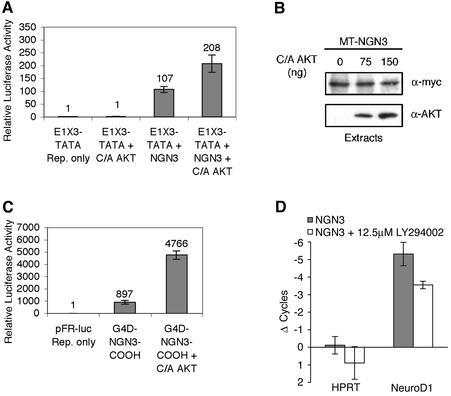FIG. 3.
Activated Akt cooperates with ngn3 to increase transcription. (A) P19 cells were transfected with expression vectors for ngn3, activated Akt1, and a multimerized E-box driving a luciferase reporter (E1X3-TATA). (B) Activated Akt does not alter the level of the ngn3 protein. P19 cells were transfected with expression vectors for Myc epitope-tagged (MT) ngn3 and increasing concentrations of activated Akt1. Extracts were prepared, and MT-Ngn3 levels were assessed by Western blot analysis with anti-Myc antibody. (C) The carboxyl-terminal transactivation domain of ngn3 mediates Akt-regulated transcriptional cooperativity. P19 cells were transfected with expression vectors for Gal4-DBD fused to the ngn3 carboxyl-terminal transactivation domain (G4D-ngn3-COOH), constitutively active Akt1, or vector control, and the pFR Gal4-responsive luciferase reporter. (D) ngn3-induced expression of NeuroD1 is reduced in the presence of the PI3K/Akt inhibitor LY294002. NeuroD1 and hypoxanthine phosphoribosyltransferase (control) mRNAs were quantitated by real-time RT-PCR from P19 cells transfected with an ngn3 vector, with or without LY294002, as indicated. The change in threshold-crossing cycle is shown for each mRNA relative to that for transfection of a control vector (a decrease in threshold crossing corresponds to an increase in the mRNA level). The reduction in NeuroD1 expression in the presence of LY294002 is significant (P < 0.02 by Student's t test). Standard deviations are indicated in panels A, C, and D.

